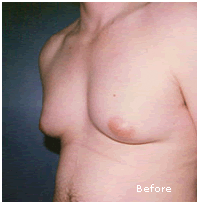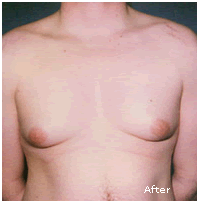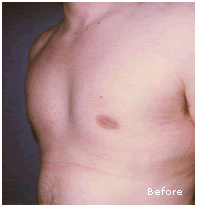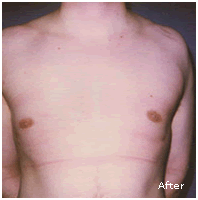Gynecomastia can also be treated by excision: the surgical removal of excess skin, tissue and fat.
Gynecomastia is a medical term used to describe breast enlargement in males. The shape of the enlarged breast may take on a feminine appearance. Gynecomastia affects about half the male population, and may affect one or both breasts. If gynecomastia occurs in teenage boys the condition is physiological and usually resolves within a year but it some cases may persist and require surgery. Certain medications such as anabolic steroids used by body builders and medical problems such as liver or endocrine abnormalities may cause gynecomastia or enlargement of the male breast but in most cases there is no known cause.
A mammogram helps to determine the type of tissue involved with the gynecomastia or breast enlargement and rule out a rare breast carcinoma.
Plastic surgery to treat gynecomastia involves the removal of the breast tissue along with some fatty tissue through an incision that goes around a portion of the nipple-areolar complex. If gynecomastia is primarily due to fatty tissue liposuction is the preferred treatment. For about three weeks after the surgery for gynecomastia, the patient wears a compression vest to control swelling.
Candidacy
The surgery may be performed on many of any age, though it is better to do it in adults, who will not grow any more. Even though teenagers would be benefited by this procedure, it is possible that they have to undergo a second surgery, as their body continues to grow.
The best candidates are men with relatively normal and steady weight and whose condition could not be solved by alternative methods. Patients must be healthy and can’t have any disease that may put their life in jeopardy, or have unhealthy habits such as the excessive consumption of tobacco, alcohol or drugs.
The patient needs to maintain a positive attitude and have specific plans to improve his physical appearance.
Reasons for considering male breast reduction or gynecomastia surgery:
- Excess breast tissue underneath the nipple and areola.
- Excess breast tissue underneath the skin of the actual breast.
- Disproportionate body frame attributed to oversized breasts.
- Protrusion of the nipple and areola caused by excess tissue.
- Loose, hanging skin over the breast resulting from massive weight loss.
Frequently asked questions?
What does the surgery consist of?
Once the patient is ready to go into de operating room, the surgeon will mark the areas that will be treated and then he will take some photos of them to compare the status before and after the surgery. When this is done, the patient will be sedated and locally anesthetized.
If the male breast reduction is caused by an excessive deposit of fat, the treatment will be done as a regular liposuction. A cannula is inserted through small incisions in the perimeter of the areola, the armpits or an area easy to hide, in order to remove the excess of fat.
Gynecomastia can also be treated by excision: the surgical removal of excess skin, tissue and fat. Incision patterns and location vary depending on the patient. The most common incision pattern is a concentric one around the areola or the natural shape of the chest. Excision techniques and concentric patterns are used when the areola has growth out of proportion and it must be reduced or repositioned.
In some cases, the male breast reduction can be treated with both techniques: liposuction and excision. Any surgical treatment to correct gynecomastia will require incisions. While some of them may be hidden with the natural shape of the body, some will be visible.
Procedure
Techniques for gynecomastia surgery vary, as mentioned above. Most procedures can be done as an outpatient under sedation anesthesia. For minimal to moderate gynecomastia, a small incision is made along the folds underneath the breast to make the tiny scar as inconspicuous as possible. Then, a type of liposuction that utilizes ultrasonic waves to help remove the fat is used to shape the breast and make it flatter by removing the excess breast tissue. After the liposuction is completed, any excess tissue beneath the nipple and areola is gently removed through the same incision used for the liposuction. Several small stitches are placed and the procedure is completed. A compression garment is also placed to keep swelling down to a minimum and to keep the breasts flat.
When severe gynecomastia is treated, an incision is made along the lower fold of the breast. Then, all of the excess breast tissue and skin is removed. In order to keep the nipple and areola in the appropriate location, the nipple/areola is removed and replaced in the correct location as a skin graft. A compression dressing is then placed over each nipple to help the graft heal and a compression garment is also used to help shape and to keep the breasts as flat as possible. Most of the time, dissolvable sutures are used, but some may have to be removed in the office one week later.
Recovery
Generally, post-operative instructions call for plenty of rest and limited movement in order to speed up the healing process and reduce the recovery time. Recovery takes 1-2 weeks, and this includes no exercise for the entire time. Bandages and a compression garment are applied immediately following surgery to aid the healing process and to minimize movement of the breasts. Once the bandages are removed, the compression garment is used for 2 more weeks, but showering is allowed. Patients sometimes report minor pain associated with surgery. Any pain can be treated with oral medication. Antibiotics are also prescribed to help prevent any infection. While complications are rare, patients can minimize potential problems by carefully following the instructions given after surgery.
Frequently asked questions?
What can I expect after gynecomastia surgery?
Usually, the chest is temporarily swollen and bruised after the surgery. You may also experience numbness or a burning sensation. You will probably be given a compression garment to wear for several weeks after the surgery.
If you have severe pain or discharge in the surgical area, or if you experience muscle aches, dizziness or a general ill feeling with fever, nausea, or vomiting, you should call your doctor immediately.
What some of the most common benefits of gynecomastia surgery?
Male breast reduction, or gynecomastia, can improve the appearance of the chest in cases where diet and exercise have failed. The results of the procedure are significant and permanent. Most men who have had surgery for gynecomastia have been very satisfied with the results.
Alternatives
In teenagers, it is best to wait for at least one year to see if the condition resolves spontaneously. In all candidates, discontinuing alcohol, marijuana or anabolic steroids may resolve the problem without surgery. Overweight men may find that losing weight will reduce breast fullness.
Risks
All surgery has some potential risks, including the risks of bleeding, reaction to the anesthetic, and infection. In this surgery, serious complications are quite rare. Other risks include:
- excessive fluid loss, leading to shock
- injury to the skin
- rippling of the skin
- excessive scarring
- pigmentation changes
- altered sensation
- insufficient tissue removed
Like all body contouring surgery, it is possible that either too much or too little tissue can be removed. In these cases, a second procedure may be necessary.
See before & after snaps of gynecomastia surgery:



